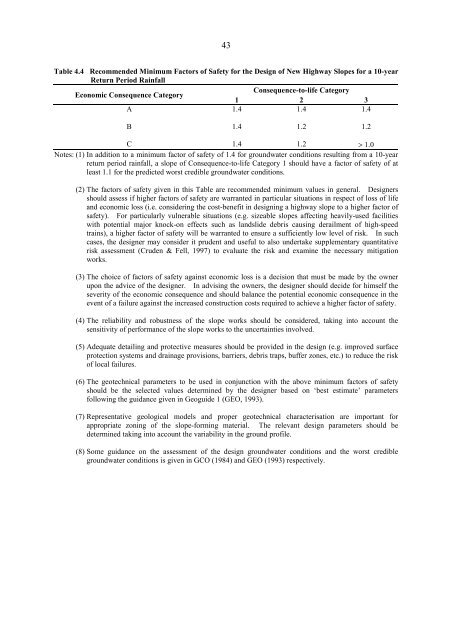Highway Slope Manual
Highway Slope Manual
Highway Slope Manual
Create successful ePaper yourself
Turn your PDF publications into a flip-book with our unique Google optimized e-Paper software.
43<br />
Table 4.4 Recommended Minimum Factors of Safety for the Design of New <strong>Highway</strong> <strong>Slope</strong>s for a 10-year<br />
Return Period Rainfall<br />
Consequence-to-life Category<br />
Economic Consequence Category<br />
1 2 3<br />
A 1.4 1.4 1.4<br />
B 1.4 1.2 1.2<br />
C 1.4 1.2 > 1.0<br />
Notes: (1) In addition to a minimum factor of safety of 1.4 for groundwater conditions resulting from a 10-year<br />
return period rainfall, a slope of Consequence-to-life Category 1 should have a factor of safety of at<br />
least 1.1 for the predicted worst credible groundwater conditions.<br />
(2) The factors of safety given in this Table are recommended minimum values in general. Designers<br />
should assess if higher factors of safety are warranted in particular situations in respect of loss of life<br />
and economic loss (i.e. considering the cost-benefit in designing a highway slope to a higher factor of<br />
safety). For particularly vulnerable situations (e.g. sizeable slopes affecting heavily-used facilities<br />
with potential major knock-on effects such as landslide debris causing derailment of high-speed<br />
trains), a higher factor of safety will be warranted to ensure a sufficiently low level of risk. In such<br />
cases, the designer may consider it prudent and useful to also undertake supplementary quantitative<br />
risk assessment (Cruden & Fell, 1997) to evaluate the risk and examine the necessary mitigation<br />
works.<br />
(3) The choice of factors of safety against economic loss is a decision that must be made by the owner<br />
upon the advice of the designer. In advising the owners, the designer should decide for himself the<br />
severity of the economic consequence and should balance the potential economic consequence in the<br />
event of a failure against the increased construction costs required to achieve a higher factor of safety.<br />
(4) The reliability and robustness of the slope works should be considered, taking into account the<br />
sensitivity of performance of the slope works to the uncertainties involved.<br />
(5) Adequate detailing and protective measures should be provided in the design (e.g. improved surface<br />
protection systems and drainage provisions, barriers, debris traps, buffer zones, etc.) to reduce the risk<br />
of local failures.<br />
(6) The geotechnical parameters to be used in conjunction with the above minimum factors of safety<br />
should be the selected values determined by the designer based on ‘best estimate' parameters<br />
following the guidance given in Geoguide 1 (GEO, 1993).<br />
(7) Representative geological models and proper geotechnical characterisation are important for<br />
appropriate zoning of the slope-forming material. The relevant design parameters should be<br />
determined taking into account the variability in the ground profile.<br />
(8) Some guidance on the assessment of the design groundwater conditions and the worst credible<br />
groundwater conditions is given in GCO (1984) and GEO (1993) respectively.

















